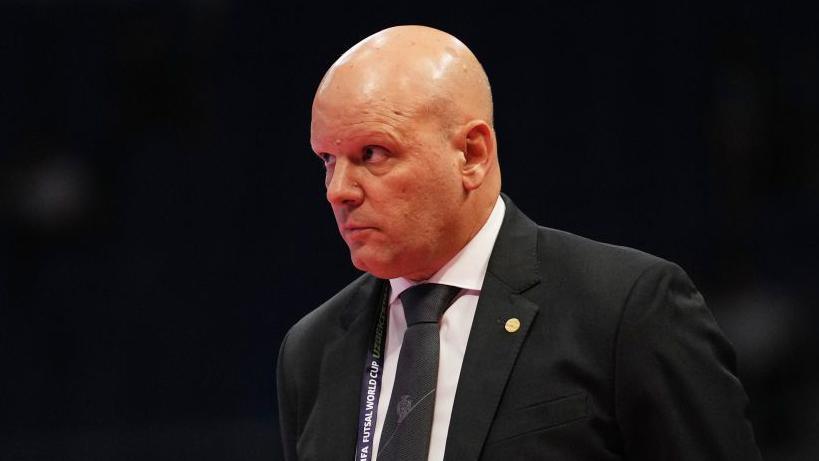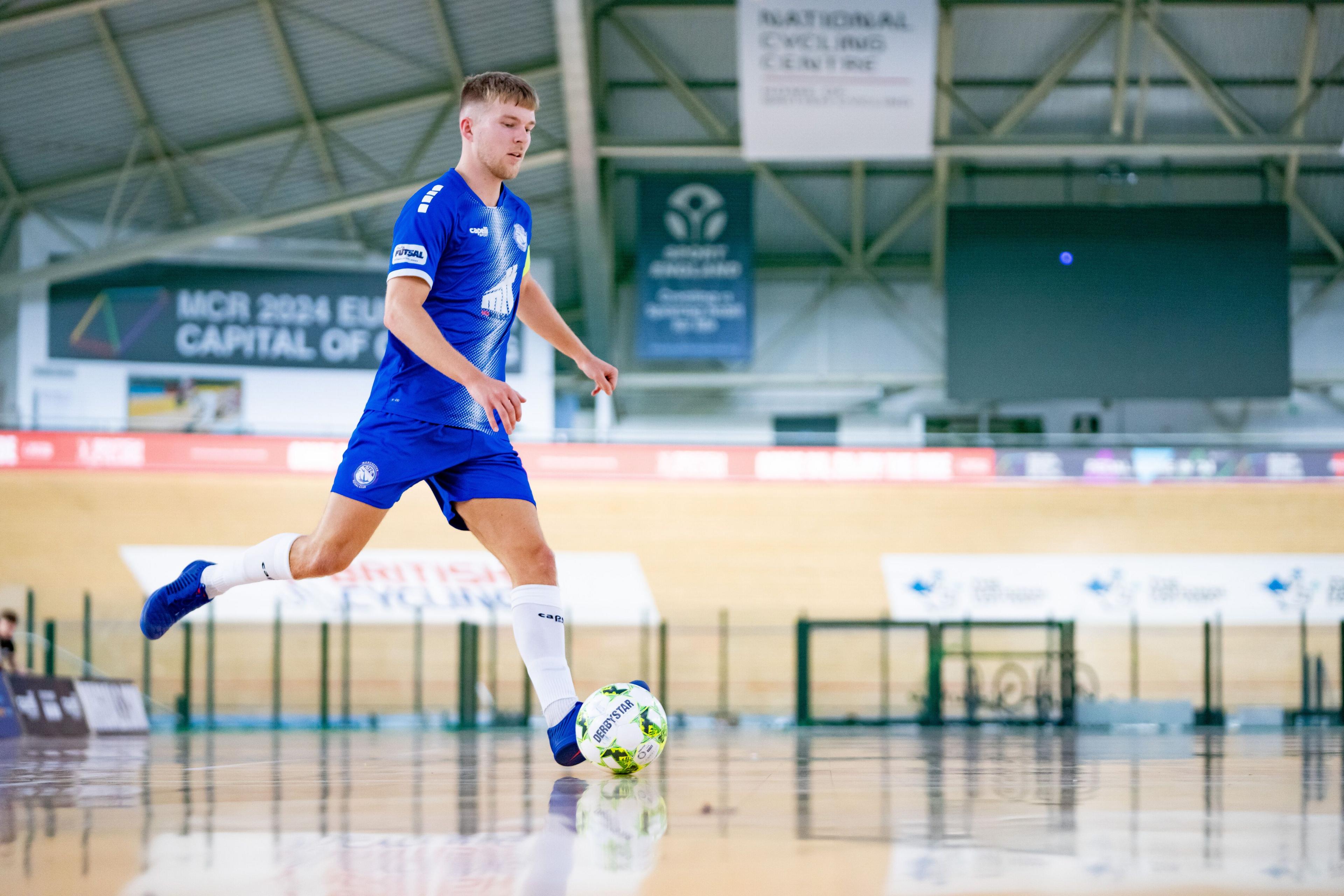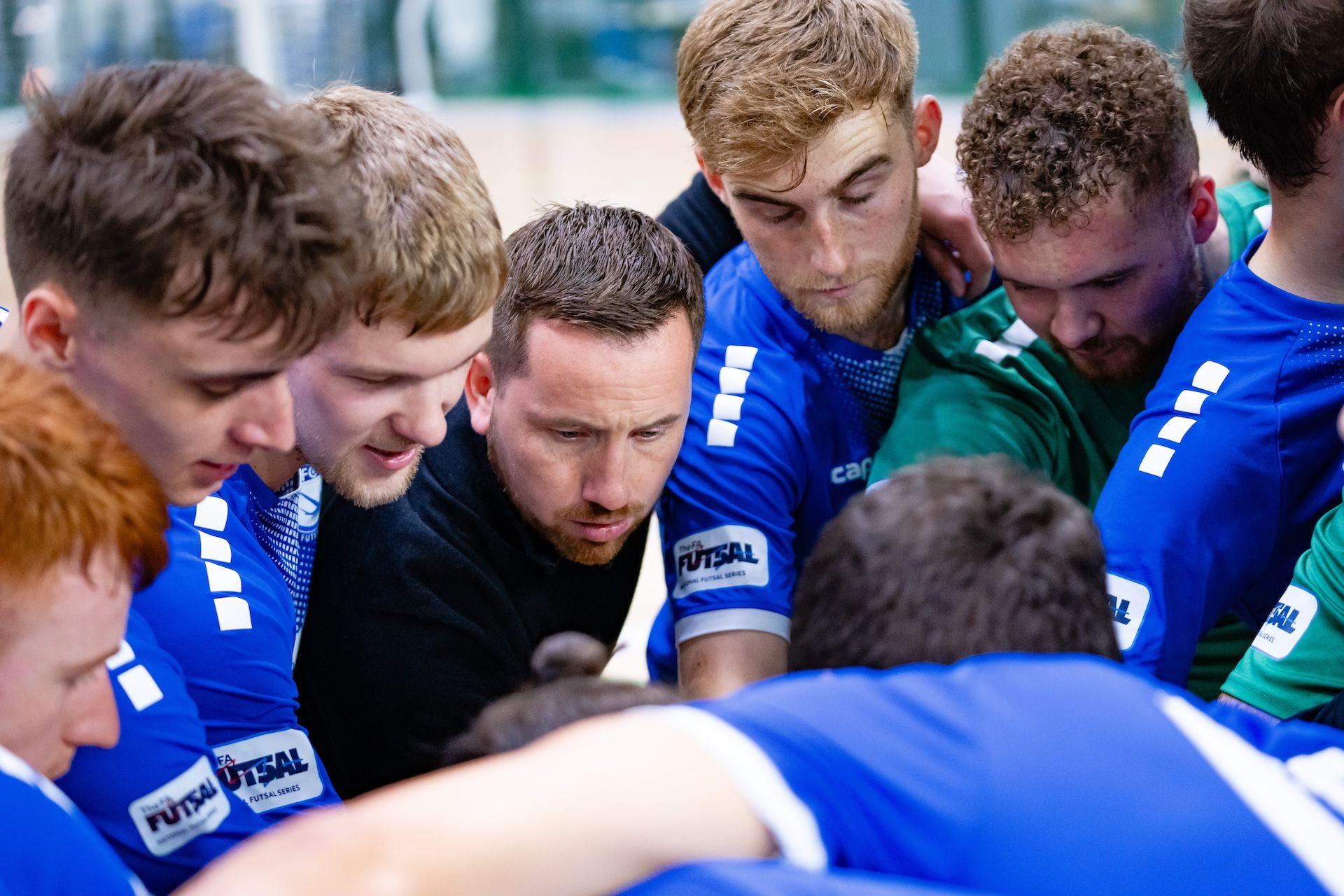How futsal is stepping out of football's shadows

This summer, the Uefa Futsal Champions League was hosted for the first time in England by Manchester Futsal Club, attracting over 2,500 spectators
- Published
It is not often you are selected to represent your country in the sport you love. It is even less often that you are among the first 14 women ever to do so.
When 18-year old Ella Brennan pulls on her England Futsal shirt for the first time against Finland this week, she and the rest of the squad will become trailblazers.
"I've always been inspired by the Lionesses, and now to be inspiring the next generation of women's futsal players is something I'm really proud of."
What is futsal? - From Montevideo to the world

Head coach of Portugal Jorge Braz believes futsal has the potential to be as popular as football
Uruguayan school teacher Juan Carlos Ceriani's goal was simple: create a game that could be played by students in small spaces and all weather.
From there, in Montevideo in the 1930s, 'futebol de salao' or 'futsal' was born.
A hard court, five against five contest played in tight spaces, with a heavier ball and at express pace - derived from football but tactically and technically evolved.
Fifa estimates futsal is now played by more than 30 million people worldwide.
Jorge Braz, Portugal's 2021 Fifa Futsal World Cup-winning coach, believes it could be the world's second biggest sport.
"Whoever comes to futsal usually stays," Braz told Futsal Street Spot, external earlier this year.
So why has a sport so globally loved been so marginalised in England's rich and diverse sporting landscape?
Financial struggles for England national teams

Ella Brennan, 18, will make her debut for England Futsal later this week against Finland
England's last senior futsal fixture was in 2019, a year before Covid-related budget cuts saw the withdrawal of all Football Association (FA) funding from the elite national futsal teams.
In 2022, England Futsal was created - a private, FA-licensed company managing the return of the senior men's side and the establishment of the Lionesses but, crucially, still without any central funding.
Nonetheless, following a period of fundraising by England Futsal, the minimum operating budget for the Lionesses was achieved.
This week they fly to Moldova for the European qualifiers of the 2025 Fifa Futsal Women's World Cup (October 16-19).
"There's an understanding of what we need to do to get the recognition for more funding and make the sport as big as possible," said Brennan, of Derby Futsal Club.

Jordan Edge, captain of Manchester Futsal Club, believes introducing futsal at a young age is key to its popularity
Both the men's and women's squads have appealed for online sponsorship and donations to help cover the costs of competing in international competitions.
The Lions remain £95,000 short of their £183,000 target, which must be reached by 25 October to prevent withdrawal from their Uefa Futsal Euro 2026 qualification group.
They say what makes this harder to swallow is France's recent success.
In 2022, the French Football Federation committed 18.5m euros to developing futsal., external Within two years, the men's French national team, on debut, reached the semi-finals of the 2024 Fifa Futsal World Cup in Uzbekistan.
Investment works, but success is built from the ground up.
Jordan Edge, captain of Manchester Futsal Club, spent time in Spain where futsal is played from an early age.
"It is all down to culture, every single school has a futsal court. Here we don't even have it as an option."
How much do players earn?
In England, futsal is an amateur sport so players do not earn salaries for competing.
Across Europe, a futsal player's earning potential varies greatly. In Spain and Portugal, clubs such as Barcelona, Sporting CP and Benfica are directly attached to their football counterparts and are able to pay lucrative salaries, with elite players thought to have had contracts upwards of £400,000 per year with Barcelona.
While not all clubs are professional, many other players in these leagues earn comfortable full-time salaries.
In England's top flight, FA National Futsal Series Tier 1, only a couple of clubs have ever been professional - and for short periods. The current extent of financial support offered to players is through expenses.
Manchester Futsal Club covers costs such as travel, kit and overnight accommodation for its squad, but for the vast majority of players in England, futsal is a hobby and an expensive one.
Between kit, monthly subs and nationwide travel, players often look to commercial sponsorship for help covering the costs.
How futsal is growing in Manchester

Ilya Ovechkin led Manchester Futsal Club to the Champions League
Simon Wright and Ilya Ovechkin co-founded Manchester Futsal Club in 2006.
They have an academy system of 300 players and use a wider network of community futsal leagues.
In June, the club won its first English top-flight league title.
In August, it hosted the Uefa Futsal Champions League for the first time in England, attracting over 2,500 spectators to the National Cycling Centre across three days.
But a stone's throw away, Manchester City's Etihad Stadium is a reminder of futsal's astronomically wealthy, 11-a-side cousin.
"Every kid grows up wanting to be a footballer and the pyramid allows you to get paid down to the eighth or ninth tier," says Ovechkin.
Later this month the club is releasing a three-part documentary, external on their Champions League journey, aiming to show a wider audience what can be achieved through playing futsal.
'Futsal is football condensed for the social media generation'
Futsal player Jamie Shawyer is helping to take the game to new audiences via his social media accounts.
"I honestly believe it can overtake football, not economically, but from a social perspective," he says.
With 1.32 million YouTube subscribers, external and over 200,000 Instagram followers, external, the player-owner of LDN Movements FC, the viral London-based club, is putting futsal on the map with fly-on-the-wall matchday content.
"Futsal is football condensed for the social media generation.
"I get so many messages from people saying they or their kids got into futsal because of the videos."
Last season saw a home fixture sell out with 500 tickets sold in two days, and Shawyer feels this success only highlights the untapped potential for English futsal clubs.
"We should have had no right to start a team and within two years have the most viewed matches in the country," he said.